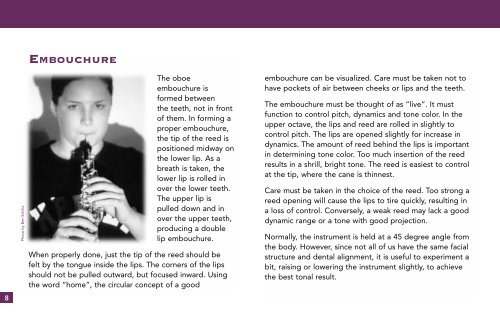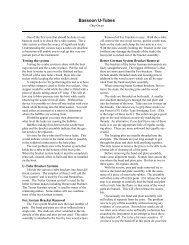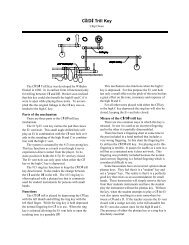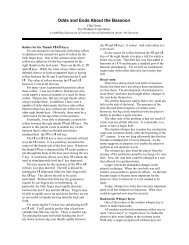Oboe playing guide for pdf - Fox Products
Oboe playing guide for pdf - Fox Products
Oboe playing guide for pdf - Fox Products
You also want an ePaper? Increase the reach of your titles
YUMPU automatically turns print PDFs into web optimized ePapers that Google loves.
8<br />
Photo by Bev Schiltz<br />
EMBOUCHURE<br />
The oboe<br />
embouchure is<br />
<strong>for</strong>med between<br />
the teeth, not in front<br />
of them. In <strong>for</strong>ming a<br />
proper embouchure,<br />
the tip of the reed is<br />
positioned midway on<br />
the lower lip. As a<br />
breath is taken, the<br />
lower lip is rolled in<br />
over the lower teeth.<br />
The upper lip is<br />
pulled down and in<br />
over the upper teeth,<br />
producing a double<br />
lip embouchure.<br />
When properly done, just the tip of the reed should be<br />
felt by the tongue inside the lips. The corners of the lips<br />
should not be pulled outward, but focused inward. Using<br />
the word “home”, the circular concept of a good<br />
embouchure can be visualized. Care must be taken not to<br />
have pockets of air between cheeks or lips and the teeth.<br />
The embouchure must be thought of as “live”. It must<br />
function to control pitch, dynamics and tone color. In the<br />
upper octave, the lips and reed are rolled in slightly to<br />
control pitch. The lips are opened slightly <strong>for</strong> increase in<br />
dynamics. The amount of reed behind the lips is important<br />
in determining tone color. Too much insertion of the reed<br />
results in a shrill, bright tone. The reed is easiest to control<br />
at the tip, where the cane is thinnest.<br />
Care must be taken in the choice of the reed. Too strong a<br />
reed opening will cause the lips to tire quickly, resulting in<br />
a loss of control. Conversely, a weak reed may lack a good<br />
dynamic range or a tone with good projection.<br />
Normally, the instrument is held at a 45 degree angle from<br />
the body. However, since not all of us have the same facial<br />
structure and dental alignment, it is useful to experiment a<br />
bit, raising or lowering the instrument slightly, to achieve<br />
the best tonal result.








